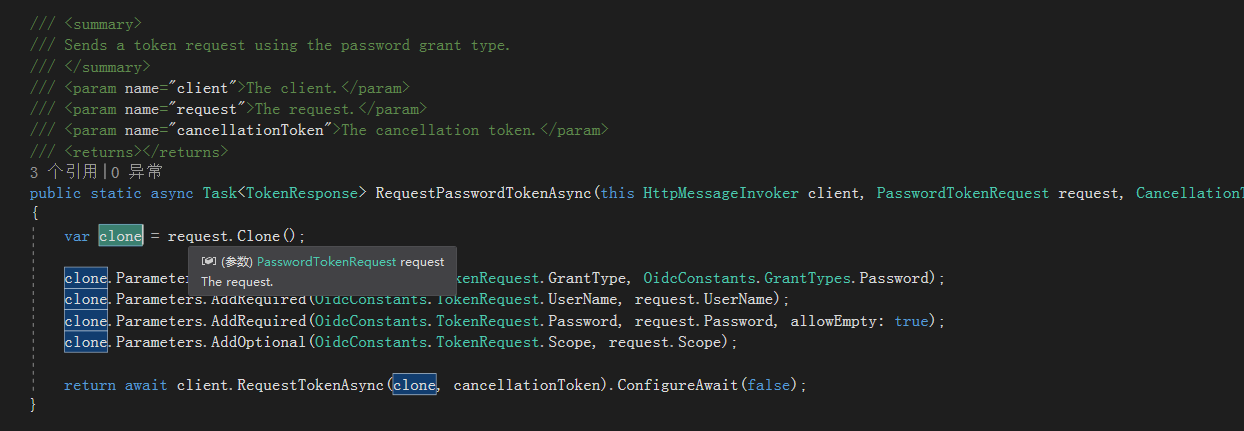首先,介绍一下问题。
由于项目中用户分了三个角色:管理员、代理、会员。其中,代理又分为一级代理、二级代理等,会员也可以相互之间进行推荐。
将用户表分为了两个,管理员和代理都属于后台,在同一张表,会员单独属于一张表。(别问我为什么不在同一张表按类型区分,俺不知道,俺也不敢问。我只是进去用新架构进行重新开发,基于原有的数据库。。)
同时后台账户不能请求会员的接口,会员也不能请求后台的接口。 他们是相互独立的两个服务。
因为要做成前后端分离,所以采用IdentityServer4进行接口授权。
oauth2 有四种授权模式:
- 密码模式(resource owner password credentials)
- 授权码模式(authorization code)
- 简化模式(implicit)
- 客户端模式(client credentials)
这篇重点不是介绍四种模式差异,有不清楚的请自行看相关资料。
我想到的有两种方案可以解决;
1.后台登陆和前台登陆都采用authorization code模式进行登陆,只是传参时加一个loginType来区分是会员还是后台账户,
在scopes里面定义所有的apiResource,当然因为登陆统一了,所以登陆时请求的scope也要根据loginType来区分(当然你也可以根据loginType来生成role角色权限,在不同的服务里面带上相应的role权限即可);
不然会员账户的access_token也可以请求后台,后台同时也可以请求会员的功能了。
这样在登陆的就能根据类型来判断应该查询哪张表。
但是这种一听就很绕,代码可读性差、后期维护难,假如突然又增加一个角色或者一张表呢。
不符合开放闭合原则。
2.就是增加新的授权模式,在IdentityServer4里面;
可以让我们使用自定义的授权码。这里我们可以好好利用了,
services.AddIdentityServer() .AddDeveloperSigningCredential() .AddInMemoryClients(MemoryConfigs.GetClients()) .AddInMemoryIdentityResources(MemoryConfigs.GetIdentityResources()) .AddInMemoryApiResources(MemoryConfigs.GetApiResources()) .AddResourceOwnerValidator<CustomPasswordOwnerUserServices>()//后台账户登录 .AddExtensionGrantValidator<CustomUserService>()//会员账户登录 //.AddAppAuthRedirectUriValidator<AuthorizationCodeService>() .AddProfileService<CustomProfileService>();
使用不同的模式,不同的clientId,在请求时会自动进行相应的模式验证;下面是会员自定义的模式验证
public class CustomUserService : IExtensionGrantValidator { private readonly IHttpClientFactory _httpClientFactory; public CustomUserService(IHttpClientFactory httpClientFactory) { _httpClientFactory = httpClientFactory; } public string GrantType => "customuserservice"; public async Task ValidateAsync(ExtensionGrantValidationContext context) { var model = new userLoginDto { phoneNumber = context.Request.Raw["Phone"], passWord = context.Request.Raw["PassWord"] }; var client = _httpClientFactory.CreateClient("userApi"); var response = await client.PostAsJsonAsync("/api/userLogin/login", model);//调用服务接口进行密码验证 response.EnsureSuccessStatusCode(); if (response.IsSuccessStatusCode) { string operatorT = await response.Content.ReadAsStringAsync(); var result = JsonConvert.DeserializeObject<OperatorResult>(operatorT); if (result.Result == ResultType.Success) { var user = JsonConvert.DeserializeObject<UserInfo>(result.Data.ToString()); List<Claim> list = new List<Claim>(); list.Add(new Claim("username", user.UserName ?? "")); list.Add(new Claim("role", string.IsNullOrEmpty(user.Role) ? "" : user.Role)); list.Add(new Claim("realname", string.IsNullOrEmpty(user.RealName) ? "" : user.RealName)); list.Add(new Claim("company", string.IsNullOrEmpty(user.Company) ? "" : user.Company)); list.Add(new Claim("roleid", string.IsNullOrEmpty(user.RoleId) ? "" : user.RoleId)); context.Result = new GrantValidationResult(subject: user.Id.ToString(), authenticationMethod: GrantType, claims: list); } else { context.Result = new GrantValidationResult(TokenRequestErrors.InvalidGrant, result.Message); } } else context.Result = new GrantValidationResult(TokenRequestErrors.InvalidGrant, "用户名密码错误"); await Task.CompletedTask; } }
下面是client配置
new Client(){ ClientId="userservices", ClientName="用户服务", ClientSecrets=new List<Secret> { new Secret("secret".Sha256()) }, AllowedGrantTypes= new List<string>{ "customuserservice" }, AccessTokenType= AccessTokenType.Jwt, RequireConsent=false, AccessTokenLifetime=900, AllowOfflineAccess=true, AlwaysIncludeUserClaimsInIdToken=true, AbsoluteRefreshTokenLifetime=86400, AllowedScopes={ IdentityServerConstants.StandardScopes.Profile, IdentityServerConstants.StandardScopes.OpenId, IdentityServerConstants.StandardScopes.OfflineAccess, "userservicesapi" }, }
当然ApiResource也要添加
new ApiResource("userservicesapi","用户服务")
接下来,就是登录了
var client = _httpClientFactory.CreateClient(); var disco = await client.GetDiscoveryDocumentAsync(new DiscoveryDocumentRequest { Address = Configuration["AuthorityConfig"], Policy = new DiscoveryPolicy { RequireHttps = false } }); if (disco.IsError) { result.Message = disco.Error; return Ok(result); } var formvalues = new Dictionary<string, string>(); formvalues.Add("scope", "profile openid offline_access userservicesapi"); formvalues.Add("Phone", loginDto.phoneNumber); formvalues.Add("PassWord", loginDto.passWord);var content = new FormUrlEncodedContent(formvalues); TokenRequest tokenRequest = new TokenRequest { GrantType = "customuserservice", Address = disco.TokenEndpoint, ClientId = "userservices", ClientSecret = "secret", Parameters = formvalues }; var tokenResponse = await client.RequestTokenAsync(tokenRequest);//自定义的授权模式请求
这样基本就完成了。登录接口就不展示了,都是一些逻辑判断。
这只是会员的登陆,后台账户的登陆跟会员的类似。修改请求的clientId和scope就行了
可以发现全程没有loginType参数,即使后面要加,完全不需要修改源代码,只需要按需扩展即可。
后面,我们看看IdentityModel基于httpclient的扩展源码,以前的TokenClient已经被舍弃了。网上能找到完整的自定义grantType授权太少了。
拿密码模式举例

第一句的clone可以先不管,就是将参数重新组装;
中间4行代码增加的一些参数,就常见的GrantType,Scope和密码模式必须的UserName和Password;
然后调用client.RequestTokenAsync方法发起请求,
接下来看RequestTokenAsync方法;说明已经加在注释里面了
internal static async Task<TokenResponse> RequestTokenAsync(this HttpMessageInvoker client, Request request, CancellationToken cancellationToken = default) { if (!request.Parameters.TryGetValue(OidcConstants.TokenRequest.ClientId, out _)) { if (request.ClientId.IsMissing()) { throw new InvalidOperationException("client_id is missing"); } } var httpRequest = new HttpRequestMessage(HttpMethod.Post, request.Address);//初始化post请求 httpRequest.Headers.Accept.Clear(); httpRequest.Headers.Accept.Add(new MediaTypeWithQualityHeaderValue("application/json")); //根据style判断是在header里面添加client_id client_secret等参数 还是在body里面添加;默认是在body里面添加 ClientCredentialsHelper.PopulateClientCredentials(request, httpRequest); //下面的就是常见的httpClient post请求 httpRequest.Content = new FormUrlEncodedContent(request.Parameters); HttpResponseMessage response; try { response = await client.SendAsync(httpRequest, cancellationToken).ConfigureAwait(false); } catch (Exception ex) { return new TokenResponse(ex); } string content = null; if (response.Content != null) { content = await response.Content.ReadAsStringAsync().ConfigureAwait(false); } //直接通过JObject转化的json实例化成TokenResponse类 if (response.StatusCode == HttpStatusCode.OK || response.StatusCode == HttpStatusCode.BadRequest) { return new TokenResponse(content); } else { return new TokenResponse(response.StatusCode, response.ReasonPhrase, content); } }
可以发现其实就是简单的post请求,只是封装了参数而已。
然后看我们的自定义RequestTokenAsync源码

可以发现只加了一个grantType,当然client_id和client_secret都在TokenReques继承的基类Request里面了。
如果有scope的话,自定义的模式请求就需要自己添加参数
formvalues.Add("scope", "profile openid offline_access userservicesapi");
自此就完成了。